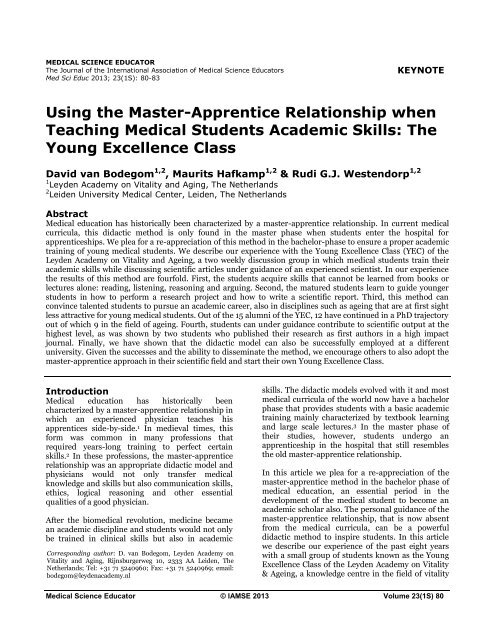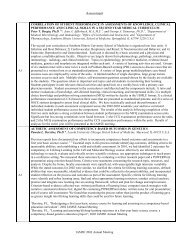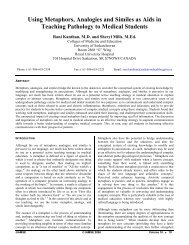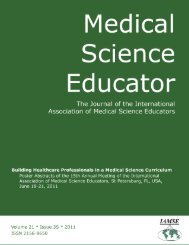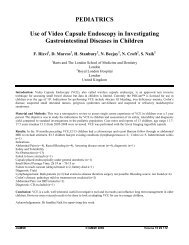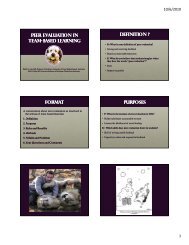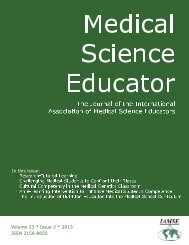MEDICAL SCIENCE EDUCATORThe Journal of <strong>the</strong> International Association of <strong>Medical</strong> <strong>Science</strong> <strong>Educator</strong>sMed Sci Educ 2013; 23(1S): 80-83KEYNOTEUs<strong>in</strong>g <strong>the</strong> Master-Apprentice Relationship whenTeach<strong>in</strong>g <strong>Medical</strong> Students Academic Skills: TheYoung Excellence ClassDavid van Bodegom 1,2 , Maurits Hafkamp 1,2 & Rudi G.J. Westendorp 1,21 Leyden Academy on Vitality and Ag<strong>in</strong>g, The Ne<strong>the</strong>rlands2 Leiden University <strong>Medical</strong> Center, Leiden, The Ne<strong>the</strong>rlandsAbstract<strong>Medical</strong> education has historically been characterized by a master-apprentice relationship. In current medicalcurricula, this didactic method is only found <strong>in</strong> <strong>the</strong> master phase when students enter <strong>the</strong> hospital forapprenticeships. We plea for a re-appreciation of this method <strong>in</strong> <strong>the</strong> bachelor-phase to ensure a proper academictra<strong>in</strong><strong>in</strong>g of young medical students. We describe our experience with <strong>the</strong> Young Excellence Class (YEC) of <strong>the</strong>Leyden Academy on Vitality and Age<strong>in</strong>g, a two weekly discussion group <strong>in</strong> which medical students tra<strong>in</strong> <strong>the</strong>iracademic skills while discuss<strong>in</strong>g scientific articles under guidance of an experienced scientist. In our experience<strong>the</strong> results of this method are fourfold. First, <strong>the</strong> students acquire skills that cannot be learned <strong>from</strong> books orlectures alone: read<strong>in</strong>g, listen<strong>in</strong>g, reason<strong>in</strong>g and argu<strong>in</strong>g. Second, <strong>the</strong> matured students learn to guide youngerstudents <strong>in</strong> how to perform a research project and how to write a scientific report. Third, this method canconv<strong>in</strong>ce talented students to pursue an academic career, also <strong>in</strong> discipl<strong>in</strong>es such as age<strong>in</strong>g that are at first sightless attractive for young medical students. Out of <strong>the</strong> 15 alumni of <strong>the</strong> YEC, 12 have cont<strong>in</strong>ued <strong>in</strong> a PhD trajectoryout of which 9 <strong>in</strong> <strong>the</strong> field of age<strong>in</strong>g. Fourth, students can under guidance contribute to scientific output at <strong>the</strong>highest level, as was shown by two students who published <strong>the</strong>ir research as first authors <strong>in</strong> a high impactjournal. F<strong>in</strong>ally, we have shown that <strong>the</strong> didactic model can also be successfully employed at a differentuniversity. Given <strong>the</strong> successes and <strong>the</strong> ability to dissem<strong>in</strong>ate <strong>the</strong> method, we encourage o<strong>the</strong>rs to also adopt <strong>the</strong>master-apprentice approach <strong>in</strong> <strong>the</strong>ir scientific field and start <strong>the</strong>ir own Young Excellence Class.Introduction<strong>Medical</strong> education has historically beencharacterized by a master-apprentice relationship <strong>in</strong>which an experienced physician teaches hisapprentices side-by-side. 1 In medieval times, thisform was common <strong>in</strong> many professions thatrequired years-long tra<strong>in</strong><strong>in</strong>g to perfect certa<strong>in</strong>skills. 2 In <strong>the</strong>se professions, <strong>the</strong> master-apprenticerelationship was an appropriate didactic model andphysicians would not only transfer medicalknowledge and skills but also communication skills,ethics, logical reason<strong>in</strong>g and o<strong>the</strong>r essentialqualities of a good physician.After <strong>the</strong> biomedical revolution, medic<strong>in</strong>e becamean academic discipl<strong>in</strong>e and students would not onlybe tra<strong>in</strong>ed <strong>in</strong> cl<strong>in</strong>ical skills but also <strong>in</strong> academicCorrespond<strong>in</strong>g author: D. van Bodegom, Leyden Academy onVitality and Ag<strong>in</strong>g, Rijnsburgerweg 10, 2333 AA Leiden, TheNe<strong>the</strong>rlands; Tel: +31 71 5240960; Fax: +31 71 5240969; email:bodegom@leydenacademy.nlskills. The didactic models evolved with it and mostmedical curricula of <strong>the</strong> world now have a bachelorphase that provides students with a basic academictra<strong>in</strong><strong>in</strong>g ma<strong>in</strong>ly characterized by textbook learn<strong>in</strong>gand large scale lectures. 3 In <strong>the</strong> master phase of<strong>the</strong>ir studies, however, students undergo anapprenticeship <strong>in</strong> <strong>the</strong> hospital that still resembles<strong>the</strong> old master-apprentice relationship.In this article we plea for a re-appreciation of <strong>the</strong>master-apprentice method <strong>in</strong> <strong>the</strong> bachelor phase ofmedical education, an essential period <strong>in</strong> <strong>the</strong>development of <strong>the</strong> medical student to become anacademic scholar also. The personal guidance of <strong>the</strong>master-apprentice relationship, that is now absent<strong>from</strong> <strong>the</strong> medical curricula, can be a powerfuldidactic method to <strong>in</strong>spire students. In this articlewe describe our experience of <strong>the</strong> past eight yearswith a small group of students known as <strong>the</strong> YoungExcellence Class of <strong>the</strong> Leyden Academy on Vitality& Age<strong>in</strong>g, a knowledge centre <strong>in</strong> <strong>the</strong> field of vitality<strong>Medical</strong> <strong>Science</strong> <strong>Educator</strong> © IAMSE 2013 Volume 23(1S) 80
and age<strong>in</strong>g connected to <strong>the</strong> Leiden University <strong>in</strong><strong>the</strong> Ne<strong>the</strong>rlandsThe MethodThe Young Excellence Class (YEC) is a discussiongroup for medical students that meets on a twoweeklybasis to discuss scientific papers on topicsrelated to ag<strong>in</strong>g and evolutionary medic<strong>in</strong>e.Currently <strong>the</strong> YEC has 16 members rang<strong>in</strong>g <strong>from</strong>2nd year medical students to those who are almostf<strong>in</strong>ished after six years of medical education. Everyyear two or three members who complete <strong>the</strong>irmedical studies leave <strong>the</strong> group and make room fortwo or three new members, who are recruited <strong>from</strong>a group of twenty students that follow an electivecourse called The Age<strong>in</strong>g Process. This three-weekcourse deals with <strong>the</strong> fundamentals of age<strong>in</strong>g,evolution as a scientific basis for <strong>the</strong> life sciencesand <strong>in</strong>volves <strong>the</strong> critical read<strong>in</strong>g of papers andplenary discussions. Students learn to perform asmall research project <strong>in</strong> couples, give a scientificpresentation and write a small scientific report.Each year, students that excel <strong>in</strong> <strong>the</strong>se activities andare enthusiastic, active participants <strong>in</strong> <strong>the</strong> smallscale discussions are <strong>in</strong>vited to jo<strong>in</strong> <strong>the</strong> YEC.YEC meet<strong>in</strong>gs start with a simple meal, last threehours and end with a glass of w<strong>in</strong>e. Dur<strong>in</strong>g ameet<strong>in</strong>g of <strong>the</strong> YEC its sixteen members criticallyappraise a scientific paper that <strong>the</strong>y have readbeforehand and engage <strong>in</strong> a discussion. Themeet<strong>in</strong>gs are presided over by one of us (RW, DvB).Members take turns <strong>in</strong> select<strong>in</strong>g a paper fordiscussion. The student that has selected <strong>the</strong> paperleads <strong>the</strong> discussion and guides <strong>the</strong> o<strong>the</strong>rs through<strong>the</strong> manuscript dur<strong>in</strong>g <strong>the</strong> meet<strong>in</strong>g. Examples oftopics discussed <strong>in</strong> <strong>the</strong> YEC <strong>in</strong>clude; <strong>the</strong> heritabilityof behavior, epigenetics, age<strong>in</strong>g <strong>in</strong> different animalspecies, <strong>the</strong> effect of caloric restriction on age<strong>in</strong>g,us<strong>in</strong>g animal models to study age<strong>in</strong>g and <strong>the</strong>evolution of longevity.Dur<strong>in</strong>g <strong>the</strong> meet<strong>in</strong>g, <strong>the</strong> selected paper is reviewedthoroughly and <strong>the</strong> ideas that are presented <strong>in</strong> it arediscussed. Systematically, <strong>the</strong> paper is scrut<strong>in</strong>izedon its hypo<strong>the</strong>sis, assumptions, methodology and<strong>the</strong> logic and <strong>in</strong>terpretation of <strong>the</strong> results. Thechairman ma<strong>in</strong>ta<strong>in</strong>s order throughout and attemptsto guide <strong>the</strong> discussions and elicits a consensus<strong>from</strong> <strong>the</strong> group. The members of <strong>the</strong> group arestimulated to br<strong>in</strong>g forward <strong>the</strong>ir views us<strong>in</strong>g validarguments and through discussion conv<strong>in</strong>ce o<strong>the</strong>rs.The chairman aids <strong>in</strong> this process by correct<strong>in</strong>g falseargumentation, by question<strong>in</strong>g <strong>the</strong> viewpo<strong>in</strong>ts ofmembers and challeng<strong>in</strong>g members to defend <strong>the</strong>irviews.Next to <strong>the</strong> meet<strong>in</strong>gs, <strong>the</strong> members of <strong>the</strong> YEC alsoassist <strong>in</strong> education <strong>the</strong>mselves. Dur<strong>in</strong>g <strong>the</strong> electivecourse ‘The age<strong>in</strong>g process’, <strong>from</strong> which <strong>the</strong> YECmembers have orig<strong>in</strong>ally been selected <strong>in</strong> previousyears, <strong>the</strong> members act as tutors to <strong>the</strong> students thatfollow <strong>the</strong> elective course and assist <strong>the</strong>m with <strong>the</strong>irsmall research project. This resembles <strong>the</strong> way olderapprentices would teach younger apprentices <strong>in</strong> <strong>the</strong>classical master-apprentice relationships.OutcomesThe YEC, an example of <strong>the</strong> master apprenticemethod of education, has provided us four ma<strong>in</strong>results. First of all, members of <strong>the</strong> YEC acquireessential academic skills <strong>from</strong> <strong>the</strong> meet<strong>in</strong>gs thatcannot be learned <strong>from</strong> books or lectures alone.They learn how to critically read a scientific paper,how to present <strong>the</strong> l<strong>in</strong>e of reason<strong>in</strong>g and <strong>the</strong>conclusions of a paper to <strong>the</strong> group and how todefend <strong>the</strong>ir views us<strong>in</strong>g scientific arguments. Theyalso learn to critically review <strong>the</strong> methodology and<strong>the</strong> underly<strong>in</strong>g assumptions of scientific articles. Inshort, <strong>the</strong>y acquire <strong>in</strong>sight <strong>in</strong> <strong>the</strong> pr<strong>in</strong>ciples ofscientific research and learn <strong>the</strong> skills of present<strong>in</strong>g,discuss<strong>in</strong>g and argumentation.Second, <strong>the</strong> vertical structure of <strong>the</strong> YEC results <strong>in</strong> agroup of students <strong>from</strong> different years of medic<strong>in</strong>e.Younger students learn <strong>from</strong> older students whohave been <strong>in</strong> <strong>the</strong> YEC for several years. Vice versa,<strong>the</strong> older students learn to guide younger students<strong>in</strong> <strong>the</strong> basics of science which is a very useful skillfor <strong>the</strong>m. The vertical structure is even fur<strong>the</strong>relaborated when YEC members dur<strong>in</strong>g <strong>the</strong> electivecourse <strong>the</strong> age<strong>in</strong>g process guide younger students <strong>in</strong>perform<strong>in</strong>g <strong>the</strong>ir own small research project andwrite <strong>the</strong>ir report.Third, YEC members have been able to get a goodappreciation of what science is about and after <strong>the</strong>irfour year membership, <strong>the</strong>y are also well preparedfor a scientific career. When <strong>the</strong>y f<strong>in</strong>ish <strong>the</strong>irmedical education and leave <strong>the</strong> YEC, most of <strong>the</strong>mcont<strong>in</strong>ue <strong>in</strong> a PhD position. In eight years’ time, 15alumni have left <strong>the</strong> YEC out of which 12 cont<strong>in</strong>ued<strong>in</strong> a PhD trajectory. Moreover, 9 out of <strong>the</strong>secont<strong>in</strong>ued <strong>the</strong>ir PhD <strong>in</strong> <strong>the</strong> field of age<strong>in</strong>g, a fieldthat has difficulty <strong>in</strong> attract<strong>in</strong>g talented students for<strong>the</strong>ir PhD positions. Many also cont<strong>in</strong>ue <strong>the</strong>irscientific career after <strong>the</strong>ir PhD trajectory, ei<strong>the</strong>r fulltime as assistant professor or part time, next to <strong>the</strong>ircl<strong>in</strong>ical specializations. PhD students also present<strong>the</strong>ir papers at YEC meet<strong>in</strong>gs. Not only do <strong>the</strong>papers <strong>from</strong> <strong>the</strong> PhD students improve <strong>from</strong> <strong>the</strong>discussions of <strong>the</strong>se meet<strong>in</strong>gs, <strong>the</strong> PhD students arealso role models for <strong>the</strong> YEC members. One of <strong>the</strong><strong>Medical</strong> <strong>Science</strong> <strong>Educator</strong> © IAMSE 2013 Volume 23(1S) 81
- Page 4 and 5: Patient Oriented Research: The Duke
- Page 8 and 9: alumni continued with a full time a
- Page 10 and 11: MEDICAL SCIENCE EDUCATORThe Journal
- Page 12 and 13: In addition to the monthly core ses
- Page 14 and 15: MEDICAL SCIENCE EDUCATORThe Journal
- Page 16 and 17: encourages students to develop and
- Page 18 and 19: MEDICAL SCIENCE EDUCATORThe Journal
- Page 20 and 21: Figure 1: The average number of pub
- Page 22 and 23: with a higher impact factor, and pu
- Page 24 and 25: 12. Green EP, Borkan JM, Pross SH,
- Page 26 and 27: in providing research opportunities
- Page 28 and 29: Figure 2: Number of projects comple
- Page 30 and 31: eing evaluated on multiple occasion
- Page 32 and 33: suggested that academic schools/dep
- Page 34 and 35: MEDICAL SCIENCE EDUCATORThe Journal
- Page 36 and 37: efficient as possible. All students
- Page 38 and 39: The layout and design of the Labora
- Page 40 and 41: effective therapy will regulate pro
- Page 42 and 43: Key WordsMedical student research,
- Page 44 and 45: 33. Darabi R, Baik J, Clee M, Kyba
- Page 46 and 47: work in a team with a faculty super
- Page 48 and 49: MEDICAL SCIENCE EDUCATORThe Journal
- Page 50 and 51: CORE COMPETENCYThe Scientific Metho
- Page 52 and 53: During Year 3, students are brought
- Page 54 and 55: APPENDIXFigure 1: Curriculum themes
- Page 56 and 57:
Figure 2: Cystic Fibrosis Case Intr
- Page 58 and 59:
Table 2: Medical Scholar Series Top
- Page 60 and 61:
Table 3: Representative research pr
- Page 62 and 63:
the M.B.Ch.B and B.Pharm. degrees r
- Page 64 and 65:
Regardless of its origins, there is
- Page 66 and 67:
References1. Eichbaum Q, Nyarango P
- Page 68 and 69:
methods, sample size and power, use
- Page 70 and 71:
Evaluation Survey by StudentsAt the
- Page 72 and 73:
DiscussionThis program was created
- Page 74 and 75:
MEDICAL SCIENCE EDUCATORThe Journal
- Page 76 and 77:
andomly divided over small groups i
- Page 78 and 79:
In our course, the example of skin
- Page 80 and 81:
MEDICAL SCIENCE EDUCATORThe Journal
- Page 82 and 83:
student/team is assigned a primaryt
- Page 84 and 85:
KeywordsResearch, Competencies, Cur
- Page 86 and 87:
conducting in-class research requir
- Page 88 and 89:
Glucose measurements are taken in s
- Page 90 and 91:
13. Basu Ray I, Henry TL, Davis W,
- Page 92 and 93:
Goals of the Research ProgramBy est
- Page 94 and 95:
Community OutcomesEach year we shar
- Page 96 and 97:
MEDICAL SCIENCE EDUCATORThe Journal
- Page 98 and 99:
AlamarBlue assay. For downregulatio
- Page 100 and 101:
development of cancer in NF1-patien
- Page 102 and 103:
coated with micro-patterns of Colla
- Page 104 and 105:
Duke Treadmill Score for Predicting
- Page 106 and 107:
and smr genes were downloaded from
- Page 108 and 109:
initial diagnosis respectively the
- Page 110 and 111:
hythm, we considered it appropriate
- Page 112 and 113:
Respiration Changes on Fowler Posit
- Page 114 and 115:
to the WHO protocol, the measure wa
- Page 116 and 117:
anesthesia techniques are safe and
- Page 118 and 119:
Spearman correlation quotient (R) a
- Page 120 and 121:
MEDICAL SCIENCE EDUCATORThe Journal
- Page 122:
International Association ofMedical
- Page 126:
MEDICAL SCIENCE EDUCATORThe Journal


